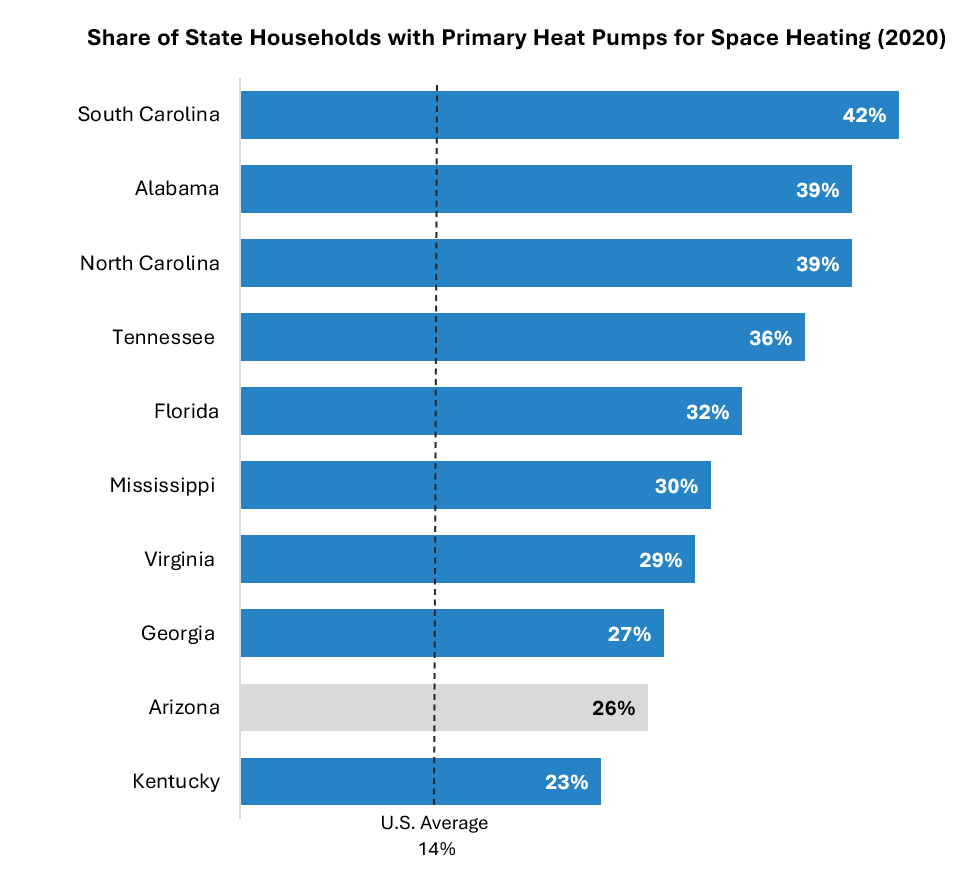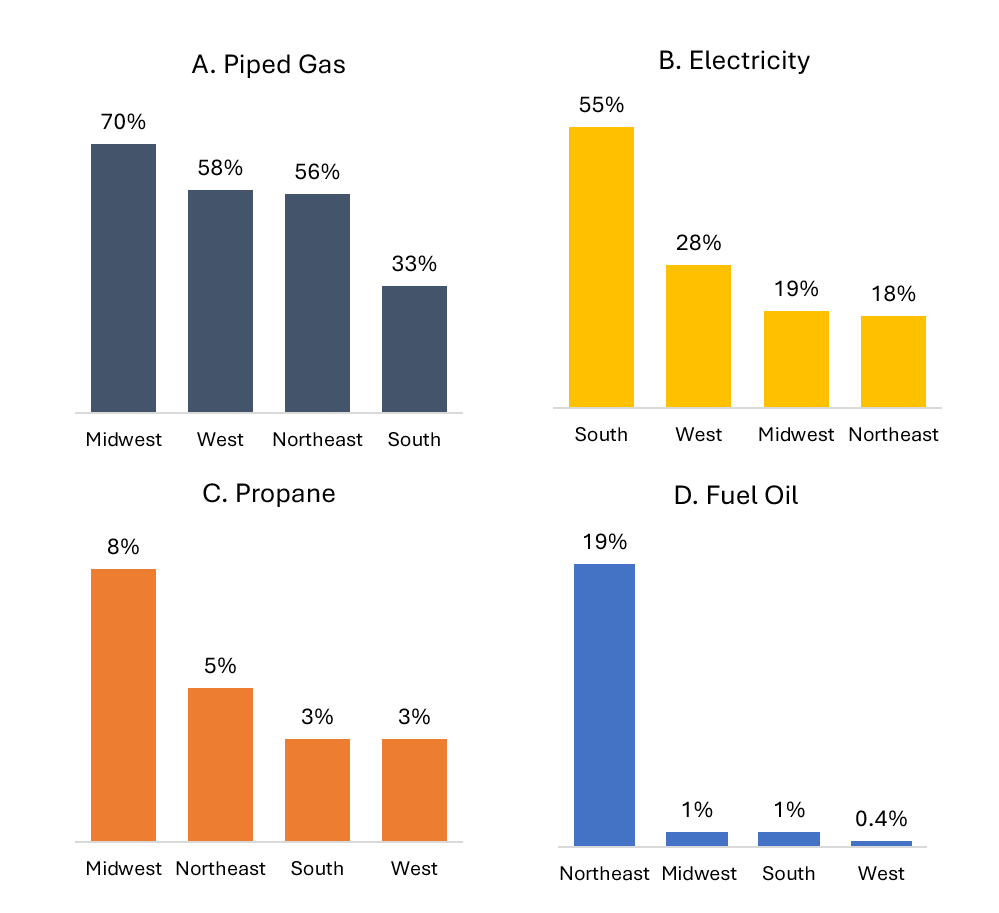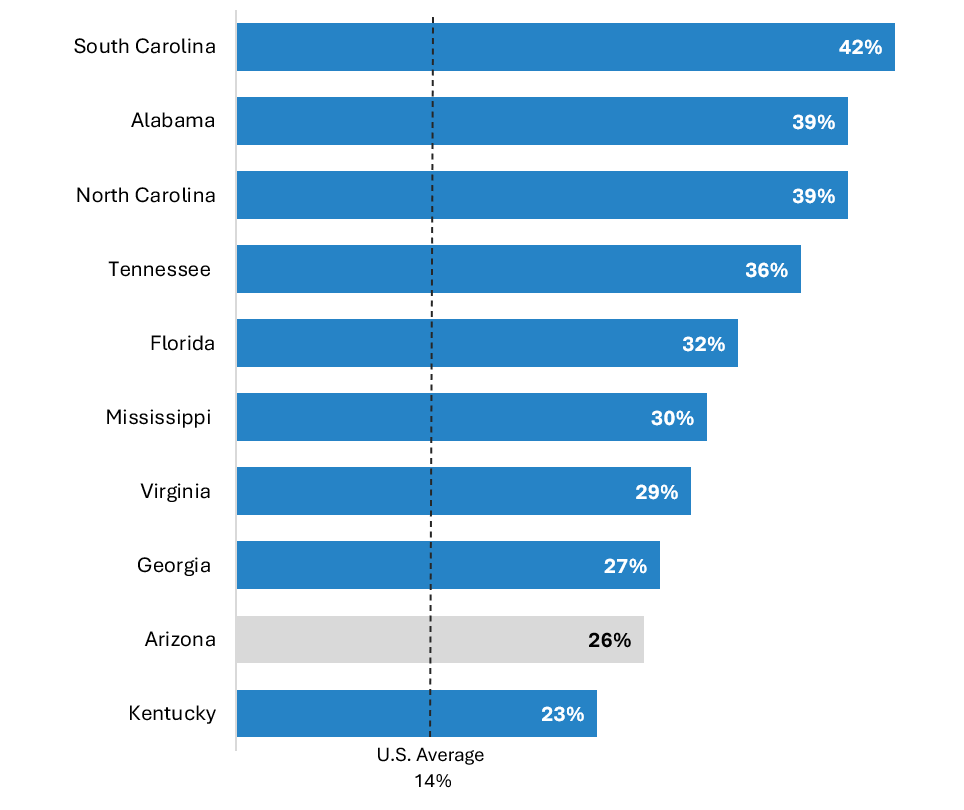
To achieve net-zero emissions by 2050 across the U.S. economy, a robust effort must be undertaken to decarbonize the buildings sector. According to the U.S. Environmental Protection Agency, direct emissions generated from residential and commercial buildings (think space heating, water heating, cooking, clothes drying) made up 13 percent of all national emissions in 2021. The single-greatest share of building emissions comes from space heating, especially from the burning of natural gas, propane, and fuel oil in furnaces and boilers to heat homes. Electric resistance heating systems, while not directly reliant on fossil fuels, are also very inefficient and contribute to greater power sector emissions.
In the push to electrify the U.S. housing stock and curb sector emissions, legislators and advocates have championed heat pump technology as the key solution to facilitate the transition from fossil-based, polluting space heating equipment to a proven, electric, and highly efficient alternative. And the message is catching on. The Inflation Reduction Act includes both tax credits and rebates to incentivize heat pump adoption, states across the country have established incentive programs to scale the industry, and utilities are subsidizing their purchase and installation now more than ever before.
But what does the heat pump and home heating market look like in the country right now? Where are we starting from and how far does the United States have to go to electrify the residential housing stock?
The following analysis was conducted using the Atlas Buildings Hub 2020 Residential Buildings Characteristics Dashboard, which pulls directly from the Energy Information Agency’s 2020 Residential Energy Consumption Survey.
U.S. Home Heating Mix
According to Atlas Buildings Hub, only one in three U.S. households reported using electricity as their primary space heating fuel in 2020 (Figure 1). Across U.S. census regions, the share of households with primary electric space heating varies widely. The South is by far the most electrified region, with 55 percent of regional households using primary electric heat, followed by the West (28 percent), Midwest (19 percent), and lastly, the Northeast (18 percent).
Figure 1: Percent of Regional Households with Primary Electric Space Heating (2020)

Source: Atlas Buildings Hub
Let’s break down the home heating mix across the country even further. In addition to being the least electrified region in the country, the U.S. Northeast is also by far the most dependent on fuel oil for primary space heating, with nearly 20 percent of regional households burning petroleum to stay warm. That is compared to just four percent of total U.S. households (Figure 2D). Maine and Vermont are the states most dependent on diesel-based heating, with 49 percent and 46 percent of households respectively reporting fuel oil as their primary space heating fuel.
Apart from the South, across all U.S. regions, a majority of households report using natural gas for primary space heating, with the Midwest topping the list at 70 percent gas dependency (Figure 2A). The states most dependent on natural gas for home heating are (in order): Utah (86 percent), Illinois (78 percent) Michigan (77 percent) Colorado (76 percent) and New Jersey (75 percent). Even in California, the national climate leader, nearly two in three households (64 percent) report natural gas as their primary space heating fuel.
Moreover, the Midwest is also the region most dependent on propane for household space heating (8 percent), with a share twice the national average of four percent (Figure 2C). States like Minnesota, the Dakotas, and Iowa all report household propane space heating dependencies of around 15 percent, nearly four times the national average.
Figure 2: Regional Fuel Dependency by Primary Space Heating Fuel

Source: Atlas Buildings Hub
National Heat Pump Market Trends
Despite lagging rates of residential electrification, the national heat pump market share has continued to grow over the past fifteen years, however slightly. According to Buildings Hub, from 2005 to 2020, the share of U.S. households that primarily use heat pumps for space heating jumped from 8 percent to 14 percent, an increase of six percentage points (Figure 3). In terms of total deployments, the number of U.S. households with primary heat pumps grew from 9.1 million to 17.2 million between 2005 and 2020. The vast majority (80 percent) of those 17.2 million households are in the U.S. South, with 14 percent residing in the West and the remaining six percent in either the Midwest or Northeast (Figure 4).
Figure 3: Percent of U.S. Households with Primary Heat Pumps (2005-2020)

Source: Atlas Buildings Hub | Includes central (ducted) heat pumps and mini-splits.
Figure 4: Households with Heat Pumps as Main Space Heating Equipment by Region Between 2005 and 2020 (millions)

Source: Atlas Buildings Hub | Includes central (ducted) heat pumps and mini-splits.
In terms of heat pump technologies, there is a clear winner across U.S. homes. Nearly all households with primary heat pumps in 2020 had central (ducted) air source heat pumps (87 percent), while seven percent had ground source heat pumps, and six percent had ductless mini-splits (Figure 5). While subsidy programs for ground source heat pumps have recently proliferated across the country, for example in places like New York and Colorado, they are still substantially more expensive than central air source heat pumps and as such are likely to remain a smaller proportion of the heat pump ecosystem.
Figure 5: Households with Primary Residential Heat Pumps, by Heat Pump Type

Source: Atlas Buildings Hub
With regard to home type, more than 60 percent of households with primary heat pumps resided in single-family detached homes, while around 25 percent lived in multi-unit dwellings (Figure 6). An additional nine percent of heat pump households lived in mobile homes and five percent resided in single-family attached homes (think rowhouses or townhomes).
The data reveals that most residential heat pumps are currently installed in single-family detached homes. These households are typically those with the greatest level of agency over their living space and HVAC equipment. They are also more readily able to take advantage of tax credits and other subsidy programs that make heat pump adoption more economically viable. And while not always, households in single-family detached homes tend to have more disposable income to invest in household upgrades.
Figure 6: Share of U.S. Households with Primary Heat Pumps, by Housing Type

Source: Atlas Buildings Hub
Heat Pump Deployment on the State Level
What does the heat pump market look like on the state level? Nearly all of the top ten heat pump states (by total number of state households with primary heat pumps) are in the U.S. South, led by Florida (2.61 million households), Texas (2.04 million), North Carolina (1.55 million), Georgia (1.06 million), and Tennessee (0.94 million) (Figure 7). While California takes the tenth spot in terms of total number of primary heat pump households (by way of having the most people generally), only four percent of households in the Golden State report having a primary heat pump, far below the national average of 14 percent (Figure 8).
Other climate-forward states are equally behind in terms of residential heat pump adoption. For example, the share of households with heat pumps in Massachusetts (4 percent), New York (4 percent), and Washington (13 percent) are all below the national average.
Figure 7: Households with Primary Heat Pumps for Space Heating by State in 2020 (millions)

Source: Atlas Buildings Hub | Includes central (ducted) heat pumps and mini-splits.
Figure 8: Share of Households in Climate-Forward States with Primary Heat Pumps for Space Heating (2020)

Source: Atlas Buildings Hub | Includes central (ducted) heat pumps and mini-splits.
This is in stark contrast to what we see across the U.S. South. In looking at the share of state households with primary heat pumps, nearly all of those in the top ten, with the exception of Arizona, are Southern states. Taking the top spot is South Carolina, where 42 percent of households report having a primary heat pump, followed by Alabama (39 percent), North Carolina (39 percent), Tennessee (36 percent), Florida (32 percent), and Mississippi (30 percent) (Figure 9). What’s more, is that more than half of the 17.2 million total U.S. households with primary heat pumps are located in just six states, all of them in the U.S. South: FL, TX, NC, GA, TN, and VA (Figure 10).
Reasons for the South’s regional dominance over the heat pump market are varied, but electricity in the region tends to be relatively cheaper, heating demand is lower, and gas pipeline infrastructure may be less cost-effective. In certain cases, like that of Florida, a significant portion of state households report not having heating equipment at all (28 percent).
Figure 9: Share of State Households with Primary Heat Pumps for Space Heating (2020)

Source: Atlas Buildings Hub | Includes central (ducted) heat pumps and mini-splits.
Figure 10: Households with Heat Pumps as Main Space Heating Equipment, Top Six States (millions)

Source: Atlas Buildings Hub | Includes central (ducted) heat pumps and ductless mini-splits.
Heat pumps offer a feasible, scalable solution to curbing building emissions. However, as is shown above, they are far from universal across the United States. But the tide is turning. According to Atlas Buildings Hub, heat pump sales outpaced those of gas and oil furnaces for the first time in 2022, with that gap only widening through the first half of 2023 (Figure 11). In 2022, 4.3 million central air source heat pumps were shipped from manufacturers to distributors (proxy for sale), in comparison to about 3.9 million gas and oil furnaces. And in the first six months of 2023, 57 percent of the total appliances shipped across those three categories were central air source heat pumps, compared with 43 percent fossil fuel furnaces.
With federal heat pump rebate programs slated to be launched across all fifty states over the next year, it is likely that heat pump sales will only continue to grow relative to their gas, oil, and propane counterparts.
Figure 11: HVAC Appliance Shipments Over Time, by Product Type (January 2013 – June 2023)

Source: Atlas Buildings Hub Appliance Shipments Dashboard | Air Conditioning, Heating, and Refrigeration Institute (AHRI)



